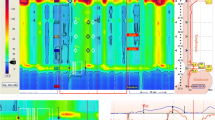Abstract
Background
Achalasia is classified into three HRM subtypes that predict outcomes from diverse management strategies. We assessed if symptomatic response varied when a single management strategy—Heller myotomy (HM)—is employed.
Methods
Treatment-naive subjects with achalasia referred for HM were followed in this observational cohort study. Chicago criteria designated achalasia subtypes (subtype I: no esophageal pressurization; subtype II: panesophageal pressurization in ≥20 % swallows; subtype III: premature contractions in ≥20 % swallows). Symptom questionnaires assessed symptom burden before and after HM on five-point Likert scales (0 = no symptoms, 4 = severe symptoms) and on 10-cm visual analog scales (global symptom severity, GSS); satisfaction with HM was recorded similarly. Data were analyzed to determine predictors of GSS change across subtypes.
Results
Sixty achalasia subjects (56.1 ± 2.4 years, 55 % female) fulfilled inclusion criteria, 15 % with subtype I, 58 % with subtype II, and 27 % with subtype III achalasia. Baseline symptoms included dysphagia (solids: 85 %, liquids: 73 %), regurgitation (84 %), and chest pain (35 %); mean GSS was 7.1 ± 0.3. Upon follow-up 2.1 ± 0.2 years after HM, GSS declined to 1.9 ± 0.4 (p < 0.001), with surgical satisfaction score of 8.7 ± 0.3 out of 10; these were similar across achalasia subtypes. On univariate analysis, female gender, Eckardt score, severity of transit symptoms, and maximal IRP predicted linear GSS improvement; female gender (p = 0.003) and dysphagia for liquids (p = 0.043) remained predictive on multivariate analysis.
Conclusions
When a uniform surgical approach is utilized, symptomatic outcome and satisfaction with therapy are similar across achalasia subtypes. Female gender and severity of dysphagia for solids may predict better HM outcome.


Similar content being viewed by others
References
Vaezi MF, Pandolfino JE, Vela MF. ACG clinical guideline: diagnosis and management of achalasia. Am J Gastroenterol. 2013;108:1238–49 (quiz 1250).
Hirano I, Tatum RP, Shi G, et al. Manometric heterogeneity in patients with idiopathic achalasia. Gastroenterology. 2001;120:789–98.
Todorczuk JR, Aliperti G, Staiano A, et al. Reevaluation of manometric criteria for vigorous achalasia. Is this a distinct clinical disorder? Dig Dis Sci. 1991;36:274–8.
Clouse RE, Staiano A, Alrakawi A, et al. Application of topographical methods to clinical esophageal manometry. Am J Gastroenterol. 2000;95:2720–30.
Pandolfino JE, Kwiatek MA, Nealis T, et al. Achalasia: a new clinically relevant classification by high-resolution manometry. Gastroenterology. 2008;135:1526–33.
Rohof WO, Salvador R, Annese V, et al. Outcomes of treatment for achalasia depend on manometric subtype. Gastroenterology. 2013;144:718–25 (quiz e13–4).
Boeckxstaens GE, Annese V, desVarannes SB, et al. Pneumatic dilation versus laparoscopic Heller’s myotomy for idiopathic achalasia. N Engl J Med. 2011;364:1807–16.
Greene CL, Chang EJ, Oh DS, et al. High resolution manometry sub-classification of Achalasia: does it really matter? Does Achalasia sub-classification matter? Surg Endosc. 2015;29:1363–7.
Bredenoord AJ, Fox M, Kahrilas PJ, et al. Chicago classification criteria of esophageal motility disorders defined in high resolution esophageal pressure topography. Neurogastroenterol Motil. 2012;24(Suppl 1):57–65.
Patel A, Sayuk GS, Gyawali CP. Acid-based parameters on pH-impedance testing predict symptom improvement with medical management better than impedance parameters. Am J Gastroenterol. 2014;109:836–44.
Reidel WL, Clouse RE. Variations in clinical presentation of patients with esophageal contraction abnormalities. Dig Dis Sci. 1985;30:1065–71.
Kushnir VM, Gyawali CP. High resolution manometry patterns distinguish acid sensitivity in non-cardiac chest pain. Neurogastroenterol Motil. 2011;23:1066–72.
Patel A, Sayuk GS, Gyawali CP. Parameters on esophageal pH impedance monitoring that predict outcomes of patients with gastroesophageal reflux disease. Clin Gastroenterol Hepatol. 2015;13:884–91.
Porter RF, Gyawali CP. Botulinum toxin injection in dysphagia syndromes with preserved esophageal peristalsis and incomplete lower esophageal sphincter relaxation. Neurogastroenterol Motil. 2011;23:139–44 (e27–8).
Gyawali CP, Kushnir VM. High-resolution manometric characteristics help differentiate types of distal esophageal obstruction in patients with peristalsis. Neurogastroenterol Motil. 2011;23:502–e197.
Kushnir V, Sayuk GS, Gyawali CP. Multiple rapid swallow responses segregate achalasia subtypes on high-resolution manometry. Neurogastroenterol Motil. 2012;24:1069–e561.
Kushnir VM, Sayuk GS, Gyawali CP. Abnormal GERD parameters on ambulatory pH monitoring predict therapeutic success in noncardiac chest pain. Am J Gastroenterol. 2010;105:1032–8.
Eckardt AJ, Eckardt VF. Treatment and surveillance strategies in achalasia: an update. Nat Rev Gastroenterol Hepatol. 2011;8:311–9.
Pratap N, Kalapala R, Darisetty S, et al. Achalasia cardia subtyping by high-resolution manometry predicts the therapeutic outcome of pneumatic balloon dilatation. J Neurogastroenterol Motil. 2011;17:48–53.
Roman S, Kahrilas PJ, Mion F, et al. Partial recovery of peristalsis after myotomy for achalasia: more the rule than the exception. JAMA Surg. 2013;148:157–64.
Hong SJ, Bhargava V, Jiang Y, et al. A unique esophageal motor pattern that involves longitudinal muscles is responsible for emptying in achalasia esophagus. Gastroenterology. 2010;139:102–11.
Roman S, Zerbib F, Queneherve L, et al. The Chicago classification for achalasia in a French multicentric cohort. Dig Liver Dis. 2012;44:976–80.
Kahrilas PJ, Boeckxstaens G. The spectrum of achalasia: lessons from studies of pathophysiology and high-resolution manometry. Gastroenterology. 2013;145:954–65.
Kahrilas PJ, Bredenoord AJ, Fox M, et al. The Chicago classification of esophageal motility disorders, v3.0. Neurogastroenterol Motil. 2015;27:160–74.
Acknowledgments
No funding or writing assistance was obtained.
Conflict of interest
The authors declare that they have no conflict of interest.
Author information
Authors and Affiliations
Corresponding author
Rights and permissions
About this article
Cite this article
Patel, A., Patel, A., Mirza, F.A. et al. Achalasia symptom response after Heller myotomy segregated by high-resolution manometry subtypes. J Gastroenterol 51, 112–118 (2016). https://doi.org/10.1007/s00535-015-1088-6
Received:
Accepted:
Published:
Issue Date:
DOI: https://doi.org/10.1007/s00535-015-1088-6




